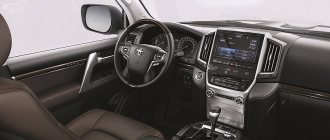Legendary cars originated decades ago. Wartime, the need for reliable technology, the demand for cars that can go anywhere - all this led to the fact that the Japanese concern decided to bring to life a bold idea. This is how the Toyota Land Cruiser appeared, which has been a popular SUV since 1954, and today also personifies the status of the owner. The latest iterations of this vehicle have become off-road icons that hundreds of other automakers can't match.
Military Origins – Toyota BJ for the Korean War
Toyota BJ The history of the SUV began in 1953, when the Japanese company began producing the Toyota BJ - the first SUV in the history of the concern.
A year later it was renamed Land Cruiser. The name change was partly a echo of the British Land Rover. Land Cruiser engines were not very diverse at first. The first SUV from the Japanese was powered by a 3.4-liter engine capable of producing 98 horsepower. Of course, not much, but for that time it was a real breakthrough. In addition, this was the first time a six-cylinder engine was used in a passenger car. Production continued until 1960.
Land Cruiser 40 – the most mature
Land Cruiser 55
In several modifications, this car lasted on the Japanese assembly line for 26 years. From 1960 to 1984, the model changed the index 40 to 55 and 60, but practically nothing changed functionally in the car. The same gasoline engine has been improved and optimized. In the 40 series of the SUV it already produced 125 horsepower, and in the 55 and 60 series – 130.
The endurance and unpretentiousness of the military engine gave rise to a disadvantage that began to matter more and more - the unit consumed too much fuel. It became clear that Toyota Land Cruiser engines require updates. Therefore, in 1970, Toyota management decided to introduce a diesel engine into the line of power units. The 3-liter 4-cylinder unit installed on the Toyota Land Cruiser BJ40 became the world's first diesel engine in a civilian passenger car. This Japanese innovation changed the course of automotive history.
Disadvantages of different Land Cruiser models
Negative aspects of cars from the Toyota manufacturer:
- Every year the reliability of components decreases - automatic transmissions, engines fail faster;
- requires a lot of fuel;
- weak acceleration dynamics;
- on some models there are no brake pad wear indicators (TLK 200 2015 with restyling);
- the high price of a used car and one purchased ex-showroom;
- door handles quickly wear out, with the exception of Prado models;
- falls over when turning;
- oil consumption has increased on 200 models after restyling in 2015;
- Do not suddenly accelerate the car or stop it - the braking distance increases.
Early Land Cruiser models were made specifically for off-road conditions, unlike modern TLK 200 vehicles, which are less resistant to off-road conditions.
Heavyweight Prado appears in the ring
Land Cruiser Prado
As a result of four years of hard work with the modernization of power units, the company did not carry out any special model updates.
The Land Cruiser FJ 62, which was released in 1985, can be considered a transitional model. It tested the now popular Toyota Land Cruiser engines. Finally, there was an improvement in the 3F petrol unit (and 3F-E for the automatic transmission). He gained 4 liters of volume, reduced fuel consumption, and also lost a fair amount of weight. 145 horsepower became a power record for the concern at that time .
The 4.2 liter 2F engine was less powerful - 140 horsepower. The company's diesel history developed in a powerful parallel stream. Produced in 1982, the 2H engine had 6 cylinders and 4 liters of displacement. It was actively used throughout the entire model range of the early 80s. In 1985 it was turbocharged and increased power to 135 horsepower. The crowning achievement of this unit was the first Prado model, released in 1987. Electronic control was added to the power unit and a new index was assigned - 2H-E. Also, the Land Cruiser was equipped with a 4-liter 12H-T diesel unit, which accommodated 20 more horses. There was also a less powerful 3B unit with 98 horsepower and a volume of only 3.4 liters.
Which Kruzak is cooler in appearance
Kruzak car owners love to compare cars by appearance. If appearance plays an important role for a future TLK driver, then you need to look at the body characteristics:
- increase in calipers for TLK 200 after restyling in 2015;
- the presence of LED head optics;
- updated dashboard, detailed maps;
- extended rear lights;
- wide tires with powerful treads;
- chrome door moldings give the car a finished look;
- five-seater cabin without rear folding beds.
The manufacturer has added disabling eco mode. After pressing this button, the car becomes even more smooth and accelerates faster. The ECU of the 200th Kruzak is reflashed after purchase. This is how the dynamics of movement are regulated.
The restyled Kruzak looks like a strong, well-thought-out model down to the smallest detail, compared to the modification before the transformation. Old models cannot be compared with new ones.
But, if a car owner is a fan of square bodies, then he will buy a TLK Prado 80 or 100. They resemble Russian UAZs in appearance, only modified and with smooth corners.
The beginning of our era – 80 series
Land Cruiser 80
The release of the Toyota Land Cruiser 80 marked the beginning of a new era in Japanese automobile manufacturing. 10 years of model release (1988-1998) became the years of formation of the Toyota brand as we know it today. And not the least role in this was played by the Land Cruiser, which began to offer a variety of engine options.
Until 1992, the gasoline family was represented by a carburetor 4-liter 3F-E unit with 155 horsepower and a 4.5-liter 195-horsepower new 1FZ-F, which was later converted to a fuel-injected 1FZ-FE engine with a power of up to 215 horses. The naturally aspirated 4.2 liter 1HZ has become a legend of the concern. Owners of a car with such a unit argued that the resource of the Toyota Land Cruiser engine cannot be exhausted. 120-136 naturally aspirated horsepower became the favorite of American farmers. There were also 4.2-liter turbocharged diesel engines 1HD-T and 1HD-FT. The power of 170 horsepower was accompanied by unprecedentedly low fuel consumption, but such cars were practically not exported to the CIS countries. Commercial vehicles were equipped with a simple 1PZ engine of 3.5 liters and 115 horses. Land Cruiser Prado was awarded smaller diesel units: 2L-T and 2LT-E 2.4 liters and 85 and 97 horses, respectively, as well as a 3-liter 1KZ-TE with 130 horses.
The eightieth generation of the iconic SUV lasted on the market until 1998, when the design was already obsolete and the engines required updating.
Comparison of technical characteristics of Land Cruisers
TLCs are distinguished not only by appearance, but also by technical characteristics. Thus, the regular 2015 Kruzak differs from the restyled TLK Prado of the same year by increased dimensions in mm, before and after, respectively:
- length 4840 – 4950;
- width 2790 – 2850;
- height 1845 – 1950.
Models after restyling are suitable for those who love wider interiors, sloping and smooth angles of frames and doors.
LC vehicles, regardless of modification, are manufactured in Japan. The only difference is the models that are created for the Asian and American markets. Modifications are supplied to Asia at low prices and with a minimum set of amenities. On the contrary, Americans need comfort and stability. You need to pay attention to this when choosing a car.
Next, the car owner needs to find out the engine power. The pre-restyled fourth generation Prado has an engine power of 177 hp. s, while the eleventh generation model already has a power of 249 hp. With. Pay attention to engine torque - 650 rpm is better than 450 rpm.
Tank volume matters. The restyled versions accommodate more fuel than previous models. So in the TLK 200 of the eleventh version, the tank holds 93 liters of fuel; if the client wishes, an additional tank of 45 liters can be installed.
Fuel consumption also differs among modifications. TLK Prado models have low consumption - 7.4 liters per 100 km. While the restyled versions of the TLK 200 are 10.6 liters (but they have more weight, wider vehicle dimensions and more powerful engines).
Anniversary “Hundredth” Land Cruiser
Land Cruiser 100
The production of the 100th generation of the SUV began a year before the 80 series was removed from the assembly line - in 1997. This car became a real breakthrough for the brand into the luxury transport market.
The range of engines was presented by both petrol and diesel units. The eight-cylinder gasoline engines had a volume of 4.7 liters, 235 horses under the hood and were labeled 2UZ-FE. Diesel units were represented by a 4.2 liter 1HD-FTE engine with 204 horsepower with incredible efficiency, low consumption and a very reliable design, as well as a younger brother 1HZ with 135 horsepower. One or two turbochargers gave the large frame SUV some drive.
A special version of the Land Cruiser 100 is the Toyota Land Cruiser Cygnus. It offered only one engine option - a 4.7 liter gasoline monster 2UZ-FE with 235 horsepower. The automatic transmission was set up perfectly, so the dynamics and driving performance of the car were at the highest level. Prado stood out here too with other units. Petrol 3RZ-FE for 150 horses and 2.7 liters (replaced by 2TR-FE, 13 horses added), 3 liter diesel engines 1KZ-TE and 1KD-FTV for 145 and 170 horses. Well, the crown of the brand is the 3.4-liter 185-horsepower 5VZ-FE gasoline unit, which in the future was replaced by a 4-liter 1GR-FE with 249 horses.
In 2007, the production of the hundredth generation Land Cruiser came to an end. Today this is one of the most popular SUVs on the secondary market, which has very roughly lost in price.
Engine Land Cruiser 200 (1VD-FTV): now even Toyota can be wrong
Without any exaggeration, the Toyota Land Cruiser 200 is an exceptional car. A heavy SUV with Full Time 4WD, all the “accessories” required for such an off-road system and impressive suspension articulation. Roomy because it's big. Convenient, because Toyota. Decently packaged, not too pretentious, relatively affordable. The main thing is that it is equally comfortable on asphalt and broken gravel. In a word, an executive sedan on an indestructible Jeep chassis. A rare combination in the era of crossovers or even large SUVs focused exclusively on good surfaces. Another pleasant moment that the “200” brought to all fans of Japanese SUVs was the diesel engine. Finally, the “people's brand” has a powerful “eight” powered by diesel fuel. And who, in its debut in 2007 or a little later, doubted that the 1VD-FTV, like the previous in-line “sixes,” would drag the car just as long and without problems, requiring only oil and fuel? To be fair, we note that there are still admirers of “One Via Di”. But there are also those who have personally experienced all the results of Toyota’s desire to get into the elite club of creators of charged diesel V8s. Let's try to be objective and find out to what extent this unit met the hopes of some and disappointed others.
In fact, Toyota needed the 1VD-FTV for a luxury SUV, like a breath of clean diesel fuel for a foreign car in the Siberian wilderness. After all, what was even the 1HD-FTE installed on the TLC 100? Another, albeit 205-horsepower with a torque of 431 Nm, version of the antediluvian 1HZ. This entire line - 1HZ, 1HD-T, etc. - is certainly legendary for its reliability and service life, as well as low-end torque. But how were these engines supposed to fit in with modern ideas about the brand's flagship? By the way, VW and, first of all, the Mercedes G- and M-Class in the late 90s and early 2000s already had large and powerful diesel V8s. The Americans have been using these on their trucks since the 80s. In general, the Toyota team was a little late.
However, catching up, they created a unit with decent characteristics. Yes, it was somewhat inferior to its competitors' analogues. Judge for yourself, Mercedes 4.0-liter OM628/629 developed 250/260 power and 560/700 Nm. 4.2 TDI from VAG, which appeared in the mid-2000s - 320–385 hp. and 650–850 Nm. 4.4-liter Range Rover unit - 313 hp. and 700 Nm. From 1VD-FTV before restyling in 2015, 235 hp were removed. and 615 Nm. After - 249 hp. and 650 Nm. But this is for Russia, in the second case exactly taking into account our taxation. For the rest of the world (Middle East, Australia, Africa, individual European countries), the G8 was boosted to 265 and 272 forces, respectively. Of course, the differences came down to software. Although in 2015, 1VD received new injectors - piezoelectric.
By the way, there are other versions of this diesel engine. Thus, for the updated veteran - Land Cruiser 70 series - a 185-horsepower 1VD modification was offered. And it is also installed on the “200”, intended for various international missions, as well as for the African, Australian, Middle Eastern, and Kazakh markets (STD, G9, DLX configurations).
Such TLC 200 have simple equipment and a manual gearbox. A “surgeon”-engineer’s knife went through the diesel engine - minus one turbine, EGR, catalyst and particulate filter. There is information that the 200 engine also does not have an intercooler. But the “seventy” (photo below) has an intercooler.
At least until 2015, there was another modification, 1VD, which was equipped with the well-packaged GX equipment for the Middle East, Kazakhstan and Australia. That diesel engine was derated to 204 hp, had an intercooler and simple turbines without variable nozzle geometry (VGT). Apparently it didn't have EGR.
Petty pranks
So what is 1VD-FTV? Cast iron block without sleeves with a 90 degree camber. There are two shafts in each head and four valves per cylinder. Valve clearances are adjusted by hydraulic compensators. The timing drive is combined. Two intermediate gears are located vertically above the crankshaft. From the latter, chains drive the intake camshafts. Graduation from them is again gears. Plus two VGT units, located on both sides of the block from the outside and “blowing” into their own row of cylinders, that is, working in parallel.
Let’s say right away that the service life of turbines is typical for all units with a similar design. That is, it all depends on the quality of the oil and proper operation - the servo drive can fail due to deposits. Removing the turbines is, however, problematic. On Land Cruisers before the 2015 update, when the 1VD was not yet equipped with a particulate filter, they can be removed without removing the entire engine. Although some people do this without any options. But three years ago DPF appeared, and it became easier to remove the engine.
The life of the chains... Forcibly, that is, after the fact of the hood, they have not yet been changed. Masters, of course, note that at runs closer to 200 thousand and after this mark, the chains stretch somewhat, but not critically. There is a known case when the chains broke and the valves met the pistons, but the drive itself was not to blame for this - the power steering was jammed.
After the same two hundred or 250 thousand, wear of the valve rocker arm bearings should be expected. This is probably due to the fact that the valve stems and guides are coking. Someone suggests installing bushings with increased length. Supposedly this eliminates the appearance of soot in fatal quantities.
Another nuance concerns the oil filter, which is a replaceable cartridge. There were cases when narrow-minded mechanics threw out the bushing and installed a new filter without it. The pressure crushed the paper and clogged the channel... It’s good if it doesn’t lead to oil starvation. And the bushing, officially offered together with the housing, can always be welded from two housing filters.
So a snotty pump after 50 thousand km is not the worst problem. However, we repeat, all the malfunctions mentioned above are either isolated, or not fatal, or caused by crooked hands. 1VD has something terrible built into it structurally.
Pour and melt
As we said earlier, in 2015 the diesel engine received different injectors - instead of electromagnetic ones, piezoelectric ones. It’s clear what Toyota was trying to achieve (and what Europe achieved before them). Due to the use of piezocrystals that change size when current is applied and raise the needle, such injectors work faster than previous ones. This allows you to increase the injection frequency per cycle. That is, to optimize processes in the combustion chamber, to make diesel more economical and more powerful. The 1VD model of 2015 actually added “horses”. We won’t talk about efficiency. But problems that were previously uncharacteristic have appeared. After all, what happened before? The maximum is draining into the return line on serious runs. Well, or failure due to fuel quality.
Electromagnetic and piezoelectric injectors
Crystal-based injectors, at least from the first batches of post-restyling Land Cruisers, failed differently. They stopped spraying fuel, pouring it into the combustion chambers. With the high pressure provided by the common rail system, it is clear what happens in such a situation - see photo below. The pistons are from 1VD with a similar fault.
This happened with runs of up to 10 thousand km. Sometimes the owners managed to contact the service to replace the injectors. In a number of cases, they arrived with a collapsed engine, in which the pistons had melted, the valves and seats had burned out, the liners had rotated and the corresponding journals had been mutilated.
At the same time, on the vast majority of TLCs, piezo injectors operate flawlessly; there are examples of runs exceeding 100 thousand km. Therefore, we undertake to make a diagnosis - something has gone wrong with Denso as a manufacturer of fuel equipment. Those batches contained defective parts.
About oil consumption. People complain about it, especially owners of cars produced before 2011, who claim that the engine can consume up to a liter per 2-3 thousand km. At the same time, some people have no expenses for waste. Obviously, this is tied to operating modes. Namely, at what speed and for how long the diesel engine operates. If you constantly turn it, oil flows through the oil separator to the intake.
Tear the cylinders? No problem!
Actually, such sins - sometimes production, sometimes repair and maintenance - will not surprise anyone now. Seems to be found in all car companies. And we would not have started this conversation if it were not for another characteristic drawback of the 1VD - critical wear of the CPG on runs, which was considered ridiculous on diesel engines of previous Cruisers. Which ones exactly?
Oh, how many copies have been broken about this! Here is a link to a video where TLC came to pick up the “capital” with a mileage of half a million km.
And in this review, the owner drove 550 thousand km and “treated” only the heads.
We also know about a mileage of 600 thousand, during which the owner, it is possible, repaired something, but did not touch the piston group and block. And I probably changed the oil more often than once every 10 thousand km (since 2012, before that, according to the regulations, diesel engines were replaced after five thousand). In general, there are similar examples. Alas, against the backdrop of cases of total wear of the CPG, they are rare.
Alternative services cite different values for its onset - a little over 140, 150, 180, 200 thousand km. The numbers are probably specific. In the sense that the mechanics, like the TLC owners who contacted them, have no point in adjusting them in either direction. However, let's keep in mind that the Cruiser is one of those cars whose mileage is lost most often. Given its excellent suspension, it is often taken for expeditions and work trips to various provinces. They cover an absolutely wild number of kilometers and then, of course, want to reduce it. So we can’t vouch for the fairness of the run here.
There is another source of information - as they say, an insider. It also turns out that there are only a few diesel Cruisers that reach impressive values on the odometer without problems. Meanwhile, in just one region there are dozens of cars with 1VD running, smoking, not developing power, and having lost compression. One can imagine the scale of the disaster within our market alone. And from the same source, a relative clarification of the mileage at which the CPG wears out - after 200 thousand.
Occasionally this happens to all cylinders. The author of the video below talks about exactly this.
More often, this fate befalls the row where the even-numbered cylinders or part of them are located. The symptoms are similar - it smokes and does not drive. Compression measurements may show less than 20 bar in some cylinders, and even 5–10 in others when the norm is 25–27. Everything obviously depends on how quickly the owner contacted the service. In other words, what final did you reach? In any case, as demonstrated in the video, we are talking about the formation of carbon deposits under the upper compression ring. Its geometry and proper operation are disrupted, and it begins to disfigure the cylinder wall. Up to this:
Some time ago, when there was no repair experience, the opinion was expressed that the wear of the CPG was caused by incorrect selection of material in the ring-cylinder wall friction pair. Based on the current data, we can say that it was provoked precisely by the occurrence of rings.
It happens that in some cylinders the rings are scuffed. In others, there are melted pistons and even more damage to the walls. There is also burnout of the valves and their seats. It is hardly possible or necessary to somehow connect these two types of damage. It's just one process superimposed on anotherWhat causes this effect? Well, it’s clear that the reason lies in the sintering of oil particles in the area of the piston rings. That is, in the process that was characteristic of the technically uncultured 90s. True, then the occurrence of rings usually did not lead to such destructive results. On modern engines, these results are almost natural - the rings and grooves under them are thinner, the drainage holes are smaller. Add here the frequency of oil changes regulated by the manufacturer after 15 thousand km (for Toyota, let us remind you, after 10 thousand), which many people follow - these are the ideal conditions for the formation of carbon deposits. Land Cruiser is, of course, not alone here. But for the phenomenon, even adjusted for the popularity of the car, to take on such a scale!? Moreover, diesel engines from relatively modern Japanese and well-studied ones - Toyota 1KD, Mitsubishi 4M41, Nissan YD25 - can suffer from anything, but not from scuffing in the CPG.
So what’s going on, why is there so much “coke” in the 1VD cylinders? Let's watch a video showing an EGR 1VD with a mileage of 27 thousand km:
Here is the same “patient” with mileage between seven and eight thousand*:
*Full version of this video is here.
Lots of soot? Repairers note that on other modern diesel engines there is sometimes no less of it in the EGR. It must be cleaned at intervals strictly dependent on the quality of the fuel and the operating mode. And the same craftsmen are careful to attribute scuffing in 1VD cylinders to dirt getting there from the exhaust gas recirculation system. And also with crankcase ventilation, located just on the side of the block with even-numbered cylinders. With caution because it is not possible to prove anything for sure at the moment. For versions without EGR, which were mentioned at the beginning of the article, there is no generalized experience. 1VD for the Russian market with a muffled system (mechanically and with subsequent software firmware) have not yet accumulated those thousands of km on the basis of which any conclusions can be drawn.
However, some repairmen, as in the video report above, are categorical - it is imperative to turn off the EGR! Let us remind you that the system not only reduces the toxicity of exhaust gases - it slightly lowers the temperature in the combustion chambers. Yes, there are many positive experiences with turning off EGR. On other diesels. How 1VD will behave after this, or more precisely, how much it leaves, is an open question.
We made a request to Toyota. Asked to answer two questions:
1. Is scuffing related to the presence of dirt in the exhaust gas recirculation system? Does it get into the cylinders, causing the upper compression rings to bind and eventually scuff the cylinder walls? If so, then why doesn’t this happen (at least so massively) with other diesel engines equipped with EGR? Is it possible to say that the EGR on the 1VD-FTV is designed incorrectly? 2. If everything is in order with the EGR, then explain the reason for such early wear of the CPG.
Unfortunately, the official representation left our questions unanswered...
A few words about the renovation
Despite the fact that only the crankshaft can be officially restored (up to size 0.25), it is possible. The first option is lining and installing pistons-rings of nominal size. It’s realistic to meet 400 thousand rubles. The second is buying a short block. Here the price tag is less humane. According to the most conservative estimates - 450 thousand. Plus a revision of the “heads” and a partial or complete update of the timing belt. The amount will easily be half a million. And the “200” still has an “automatic” in the current trend - not like the previous indestructible gearboxes. There is a suspension... With the cost of a Land Cruiser in the first years of production being 1,700,000–2,000,000 rubles, in the worst case scenario, it is realistic to invest half of its price in the car.
How to avoid getting a diesel repair? Unfortunately, there is no guaranteed recipe. It is clear that when purchasing TLC, not just diagnostics are required - compression measurements, and possibly examination of the cylinders using an endoscope. During operation, it is vitally important to change the oil after five thousand km and constantly assess the condition of the air filter and recirculation system. In the latter case, cleaning is not done after some tens of thousands of km, but after the fact. Well, or an alternative option is to purchase a gasoline Cruiser. Neither the 2UZ-FE nor the 1UR-FE that replaced it suffer from “diesel” ailments.
The latest generation – immediately plus 100
Land Cruiser 200
The Japanese themselves were probably surprised at how high they were able to jump in the development of the new Land Cruiser 200, which began production in 2007. After all, they added not ten points to the car’s index, as was before, but as many as a hundred.
The car retains all the advantages that have ensured the popularity of the family of Japanese SUVs for years. Frame design, impenetrable suspension, high ground clearance and incredible comfort - all this remains at the highest level.
Cars with automatic transmissions are imported into the CIS countries. One diesel unit with a capacity of 235 horsepower, 4.5 liters and a volume of 1VD-FTV is offered. And two petrol ones: a 4.6-liter 1UR-FE engine with a record 309 horsepower and a less powerful 4.7-liter 2UZ-FE with 288 horses. Toyota LC Prado continues to use the iconic 2TR-FE and 1GR-FE petrol units.
So far the Japanese have not announced a generation change, although there are doubts that the 200 series will remain on the production line for too long. The pace of development of SUVs in the world has increased so much that updates will have to be done much more often.
Constantly growing popularity
From the release of the first Toyota BJ model to the latest versions of the Land Cruiser, the car's popularity has only increased. The introduction of the latest technologies, Japanese meticulousness in the smallest details, quality of assembly and materials - all this gives results.
The popularity of the car in the world is evidenced by the fact that it is easier to find a contract engine for a Toyota Land Cruiser than a unit for any other car.
The quality of the Japanese concern and its attitude to business make Toyota cars a desirable purchase for every person. Let's hope that future generations of the SUV series will be no less attractive in all respects.











